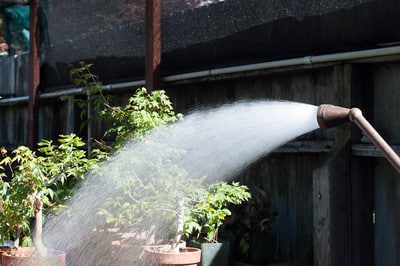I find watering this time of year to be challenging. Yesterday only about 6 of my trees needed water – the others were fine. Before and after work it is dark out. This morning the hose was frozen and no water would come out.

Watering in spring – how nice!
In colder areas, trees are moving into winter storage areas and facing increasing amounts of snow. Whatever the climate, the cold or dormant season poses challenges to tree health. If I don’t water trees selectively, over or under-watering can stress trees and facilitate fungus growth or infestations – problems that are hard to address in winter for trees that are semi-dormant. Insects are a particular problem where I live because it doesn’t get cold enough to discourage pests like pine needle scale. Even though fall is a great time to perform many bonsai tasks, tree health comes first.
What to do? Good question. I often spray insecticides in fall or winter to get ahead of pests that can take over quickly in spring. When I plan ahead, I give my trees a dose of systemic pesticides toward the end of the growing season to inoculate them through winter and early spring. When watering, I try to identify trends relating to which trees dry out quickly and which dry out slowly. Even if like sizes and varieties aren’t grouped together in the garden, knowing which need the most water helps me stay on top of the task.
A particular pine in my garden has been thirsty almost every day this month – possibly a sign that it needs repotting. If the soil has broken down over several years, drainage can decline making it harder to give trees a proper dose of water. A quick chopstick test can help determine whether or not a tree needs repotting (if the chopstick goes in easily, the tree is less likely to need repotting).
If I’m not around the garden during daylight hours, I’ll sometimes dig into the soil a little ways in the dark and feel how moist the soil is. I’ve also relied on assistance from friends and neighbors when I need help with the watering.
A good hedge against many of these challenges is soji – removing the top layer of soil to encourage good drainage (see “Summer soji”). One of the best benefits of this is simply interacting with trees that may not otherwise need work this time of year. Taking these trees off of the bench for a few minutes and looking them over can reveal nascent infestations and make clear whether or not a tree is thirsty. When the work is done, it’s far easier to gauge the drainage which can help determine whether or not spring repotting is in order. Soji can also help with weeds and make the garden look tidy.
Winter remains one of my favorite bonsai seasons because trees prepped for exhibit this time of year can look fantastic. I’ve found it’s not, however, a time to take much of a break from basic maintenance activities.
Subscribe to Bonsai Tonight
New Posts Delivered Every Tuesday and Friday
Greg Wentzel says
How do yo winter your trees in colanders?
Jonas Dupuich says
Hi Greg – I keep all of my trees outside in winter as I don’t get hard freezes where I live.